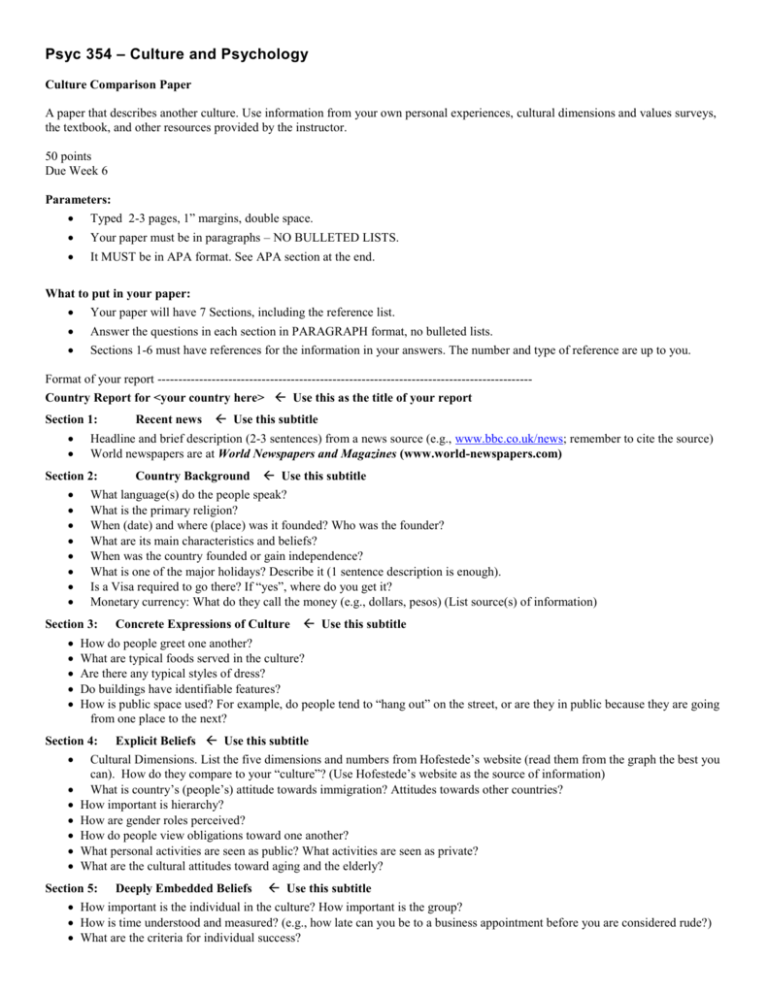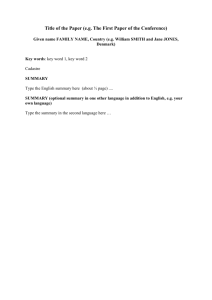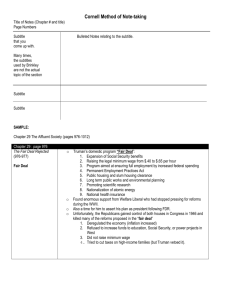Culture Comparison Assignment
advertisement

Psyc 354 – Culture and Psychology Culture Comparison Paper A paper that describes another culture. Use information from your own personal experiences, cultural dimensions and values surveys, the textbook, and other resources provided by the instructor. 50 points Due Week 6 Parameters: Typed 2-3 pages, 1” margins, double space. Your paper must be in paragraphs – NO BULLETED LISTS. It MUST be in APA format. See APA section at the end. What to put in your paper: Your paper will have 7 Sections, including the reference list. Answer the questions in each section in PARAGRAPH format, no bulleted lists. Sections 1-6 must have references for the information in your answers. The number and type of reference are up to you. Format of your report -----------------------------------------------------------------------------------------Country Report for <your country here> Use this as the title of your report Section 1: Recent news Use this subtitle Headline and brief description (2-3 sentences) from a news source (e.g., www.bbc.co.uk/news; remember to cite the source) World newspapers are at World Newspapers and Magazines (www.world-newspapers.com) Section 2: Country Background Use this subtitle What language(s) do the people speak? What is the primary religion? When (date) and where (place) was it founded? Who was the founder? What are its main characteristics and beliefs? When was the country founded or gain independence? What is one of the major holidays? Describe it (1 sentence description is enough). Is a Visa required to go there? If “yes”, where do you get it? Monetary currency: What do they call the money (e.g., dollars, pesos) (List source(s) of information) Section 3: Concrete Expressions of Culture Use this subtitle How do people greet one another? What are typical foods served in the culture? Are there any typical styles of dress? Do buildings have identifiable features? How is public space used? For example, do people tend to “hang out” on the street, or are they in public because they are going from one place to the next? Section 4: Explicit Beliefs Use this subtitle Cultural Dimensions. List the five dimensions and numbers from Hofestede’s website (read them from the graph the best you can). How do they compare to your “culture”? (Use Hofestede’s website as the source of information) What is country’s (people’s) attitude towards immigration? Attitudes towards other countries? How important is hierarchy? How are gender roles perceived? How do people view obligations toward one another? What personal activities are seen as public? What activities are seen as private? What are the cultural attitudes toward aging and the elderly? Section 5: Deeply Embedded Beliefs Use this subtitle How important is the individual in the culture? How important is the group? How is time understood and measured? (e.g., how late can you be to a business appointment before you are considered rude?) What are the criteria for individual success? How is divine power viewed in relation to human effort? What is the role of luck in people’s lives? Is the culture a high-context or low-context one? How do individuals “know” things? (e.g., are people encouraged to question things? are they encouraged to master accepted wisdom?) Section 6: Comparison Use this subtitle Compare this culture to the culture that you wrote about in your first paper. Be specific in your answer (e.g., use Hofstede numbers, etc.). References are not required for this section. o What similarities did you notice? o What differences did you notice? How would they affect your awareness and ease of travel or assimilation in the culture? o What other comments or thoughts do you have? NOTE: You can express your opinions here, but be thoughtful, not opinionated. Anything you say you should be able to back up with an example or reference (but references aren’t needed in this section). Section 7: References Use this subtitle Put all your sources here in APA format, in alphabetical order. No required number. Use a separate piece of paper. Put a title at the top called “References” Cite every source you use: Textbook, articles, websites. Cite your sources of information in the body of your paper and in your reference page. That means that every source in your reference list must be cited in the body of the report and vice versa. It is okay to you the textbook as a source. Resources for your paper ---------------------------------------------------------------------------------------------------------------You can use these resources in your report. Most everything you need is in them. Citation examples are provided for some sources. Geert Hofstede – http://geert-hofstede.com Schwartz, S.H. (2005). Basic Human Values: An Overview - www.unienna.it/scienzepsicologiche/doc/tirocinio/Schwartz_paper.pdf The World Factbook - https://www.cia.gov/library/publications/the-world-factbook/index.html Example In text citation: (CIA, 2010) Example In reference list: Central Intelligence Agency. (2010). Argentina. In The World Factbook. Retrieved from https://www.cia.gov/library/publications/the-world-factbook/geos/ar.html Country profiles from Kwintessential - www.kwintessential.co.uk/resources/country-profiles.html Example In text: (Kwintessential, n.d.) Example In reference list: Kwintessential. (n.d.). Iraq - Language, Culture, Customs and Etiquette. In International Etiquette Guide. Retrieved from http://www.kwintessential.co.uk/resources/global-etiquette/iraq.html. Countries and Their Cultures www.everyculture.com/index.html U.S. State Department, Fact sheets - www.state.gov/r/pa/ei/bgn/index.htm Example In text: (Dept .of State, 2010) Example In reference list: U.S. Department of State (2010). Argentina. Retrieved from http://www.state.gov/r/pa/ei/bgn/26516.htm. E.T. Hall – High vs Low Context, very good summary of Hall’s work http://changingminds.org/explanations/culture/hall_culture.htm http://www.culture-at-work.com/highlow.html Country Profiles from BBC - http://news.bbc.co.uk/2/hi/country_profiles/default.stm Cross-culture communication from Univ of Northern Iowa - www.cba.uni.edu/buscomm/InternationalBusComm/Crosscultural.html Types of cultures from Univ of Northern Illinois - www.cba.uni.edu/buscomm/InternationalBusComm/Characteristics.htm Freedom House - An excellent online resource for students researching the degree of freedom and democracy in countries around the world. Library of Congress Country Studies - www.freedomhouse.org/template.cfm?page=1 ReligionFacts - free, reliable information on a wide variety of world religions - www.religionfacts.com/ The Elements of Culture - http://faculty.mdc.edu/jmcnair/Joe4pages/elements_of_culture.htm Religion And Culture - www.mesacc.edu/dept/d10/asb/religion/index.html How to Paraphrase ------------------------------------------------------------------------------------------------------- --------Change words and word order. Break 1 sentence into 2 sentences. Put many sentences into one sentence by taking the main word or words and use commas. A quote – not recommended: The study found that “…children who were highly active and who had problems controlling their behavior had more conflict with mothers than less active children and children who did not have trouble controlling their behavior.” (Sciencedaily, 2008, para. 4). Paraphrased – better– broken into 2 sentences: One study (Sciencedaily, 2008) found that that amount of conflict was related to a child’s temperament. Children who showed the most conflict with their mothers also tended to be more active and to have more behavior control problems than other children. APA Style ---------------------------------------------------------------------------------------------------------------Need help with APA? The 2 BEST sources of information are … http://owl.english.purdue.edu/owl/resource/560/05/ - or Google OWL APA. Look at the tabs on the left. http://bcs.bedfordstmartins.com/resdoc5e/RES5e_ch09_s1-0002.html. Select the type of source you have (in the middle of the screen). Also shows how to do all sorts of in-text citations (see tab at left). Citing one article that is in another article It’s called Citing Indirect Sources: http://owl.english.purdue.edu/owl/resource/560/03/ If you want use a source that is cited in an article, name the original source in your sentence. Put the secondary source (the article you are reading) AND the page number in your sentence as follows. Example: Johnson (as cited in Goldstein, 2010, p. 102) stated that ... . Then put Goldstein in your reference list. Grading --------------------------------------------------------------------------------------------------------------- For an “A” o Meet all formatting requirements (paragraphs, titles, APA, summary, etc.) o Extra sources of information are peer reviewed scientific articles o Have more than 6 sources of information o Use paraphrased examples, not quotes, from your sources.


